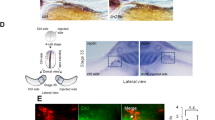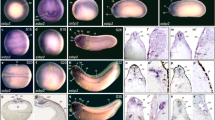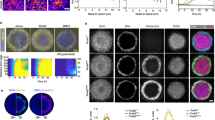Abstract
DURING early vertebrate embryogenesis, mesoderm is specified by a signal emanating from prospective endoderm. This signal can respecify Xenopus prospective ectoderm as mesoderm, and can be mimicked by members of the fibroblast growth factor and transforming growth factor-β families1,2. In other systems, the p21c-ras proto-oncogene product has been implicated in signal transduction for various polypeptide growth factors. We report here that a dominant inhibitory ras mutant blocks the mesoderm-inducing activity of fibroblast growth factor and activin, as well as the endogenous inducing activity of prospective endoderm. A constitutively active ras mutant partially mimics these activities. These results indicate that p21ras may have a central role in the transduction of the mesoderm inductive signal. Basic fibroblast growth factor3,4 and activin5–8 have emerged as candidates for endogenous mesoderm-inducing molecules. The character of the mesoderm induced by these two factors is overlapping but distinct when assessed both by histological and molecular criteria9,10. The signal transduction pathways used during induction by these factors are unknown. We used messenger RNA microinjection of Xenopus eggs to express a dominant inhibitory mutant ras, p21(Asn 17)Ha-ras, in cells competent to respond to inducing factors to examine the role of p21ras in this response. This mutant, which has a reduced affinity for GTP relative to GDP11, blocks a variety of mitogenic signals in 3T3 fibroblasts12 as well as the differentiation of pheochromocytoma cells in response to nerve growth factor13.
This is a preview of subscription content, access via your institution
Access options
Subscribe to this journal
Receive 51 print issues and online access
$199.00 per year
only $3.90 per issue
Buy this article
- Purchase on Springer Link
- Instant access to full article PDF
Prices may be subject to local taxes which are calculated during checkout
Similar content being viewed by others
References
Smith, J. C. Development 105, 665–667 (1989).
Whitman, M. Melton, D. A. Rev. Cell Biol. Vol. 5, 93–117 (1989).
Slack, J. M. W., Darlington, B. G., Heath, J. K. & Godsave, S. F. Nature 326, 197–200 (1987).
Kimelman, D., Abraham, J. A., Haaparanta, T., Palishi, T. M. & Kirschner, M. W. Science 243, 1053–1057 (1988).
Smith, J. C., Price, B. M. J., Van Nimmen, K. & Huylebroeck, D. Nature 345, 729–731 (1990).
Thomsen, G. et al. Cell 63, 485–493 (1990).
Asashima, M. et al. Wilhelm Roux Arch. dev. Biol. 198, 330–335 (1990).
Mitrani, E. et al. Cell 63, 495–501 (1990).
Ruiz i Altaba, A. & Melton, D. A. Nature 341, 33–38 (1989).
Godsave, S. F., Isaacs, H. V. & Slack, J. M. W. Development 102, 555–566 (1988).
Feig, L. A. & Cooper, G. M. Molec. cell. Biol 8, 3235–3243 (1988).
Cai, H., Szeberenyi, J. & Cooper, G. Molec. cell. Biol. 10, 5314–5323 (1990).
Szebernyi, J., Cai, H. & Cooper, G. Molec. cell. Biol. 10, 5324–5332 (1990).
Symes, K. & Smith, J. Development 101, 339–345 (1987).
Sokol, S., Wong, G. G. & Melton, D. A. Science 249, 561–564 (1990).
Smith, J. C. Cell 67, 79–88 (1991).
Jamrich, M., Sargent, T. & Dawid, I. B. Genes Dev. 1, 124–132 (1987).
Sokol, S., Christian, J. L., Moon, R. T. & Melton, D. A. Cell 67, 741–752 (1991).
Nieuwkoop, P. D. Wilhelm Roux Arch. EntwMech. Org. 162, 341–373 (1969).
Daar, I. et al. Science 253, 74–76 (1991).
Hall, A. Science 249, 635–640 (1990).
Barbacid, M. A. Rev. Biochem. 56, 779–827 (1987).
Hall, A. Cell 61, 921–923 (1990).
Whitman, M. & Melton, D. A. Science 244, 803–806.
Lee, P. L., Johnson, D. E., Cousens, L. S., Fried, V. A. & Williams, L. T. Science 245, 57–60 (1989).
Mathews, L. S. & Vale, W. W. Cell 65, 973–982 (1991).
Newport, J. & Kirschner, M. Cell 30, 675–686 (1982).
Krieg, P. A. & Melton, D. A. Meth. Enzym. 155, 397–415 (1987).
Gurdon, J. B., Fairman, S., Mohun, T. J. & Brennan, S. Cell 41, 913–922 (1985).
Author information
Authors and Affiliations
Rights and permissions
About this article
Cite this article
Whitman, M., Melton, D. Involvement of p21ras in Xenopus mesoderm induction. Nature 357, 252–254 (1992). https://doi.org/10.1038/357252a0
Received:
Accepted:
Issue Date:
DOI: https://doi.org/10.1038/357252a0
This article is cited by
-
RAS-independent ERK activation by constitutively active KSR3 in non-chordate metazoa
Nature Communications (2023)
-
Small GTP-binding Proteins and their Functions in Plants
Journal of Plant Growth Regulation (2007)
-
C3G regulates the size of the cerebral cortex neural precursor population
The EMBO Journal (2006)
-
Oncogenic Met receptor induces ectopic structures in Xenopus embryos
Oncogene (2006)
-
The transmembrane protein XFLRT3 forms a complex with FGF receptors and promotes FGF signalling
Nature Cell Biology (2004)
Comments
By submitting a comment you agree to abide by our Terms and Community Guidelines. If you find something abusive or that does not comply with our terms or guidelines please flag it as inappropriate.



